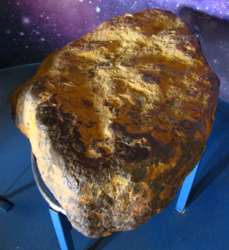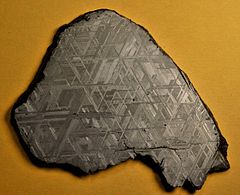- Muonionalusta
-
Muonionalusta 
The Muonionalusta, on loan to the Prague National Museum in 2010. It is the largest meteorite ever exhibited in the Czech Republic. Type IVA (Of) Class Octahedrite Group Iron Structural classification Fine Octahedrite Composition Ni, Ga, Ge Country Sweden Region Norrbotten Coordinates 67°48′N 23°6.8′E / 67.8°N 23.1133°ECoordinates: 67°48′N 23°6.8′E / 67.8°N 23.1133°E Observed fall No Found date 1906 Full slice (across 9.6cm) of the Muonionalusta, showing the Widmanstätten pattern. 
The Muonionalusta is a meteorite classified as fine octahedrite, type IVA (Of). The first fragment of the Muonionalusta was found in 1906 in a 25 x 15 km area approximately 140 km north of the Artic Circle, in the Pajala district, Norbbotten, Sweden.[1] Around fourty pieces are known today, some being quite large.
It was first described in 1910 as Muonionalusta, therefore named after the municipality of Muonio, by professor A. G. Högbom and studied in 1948 by Professor Nils Göran David Malmqvist.[2] The Munionalusta, probably the oldest meteorite known to man, marks the first occurence of stishivite in an iron meteorite.[1]
Contents
Description
Studies have shown it to be the oldest discovered meteorite impacting the Earth during the Quaternary period, about one million years ago. It is quite clearly part of the iron core or mantle of a planetoid, which shattered into many pieces upon its fall on our planet.[3] Since landing here this meteorite has experienced four ice ages. It was unearthed from a glacial moraine in the northern tundra. A strongly weathered surface covered with cemented facetted pebbles leaves no doubt that its sojourn on Earth has been long and dramatic.
Composition
New analysis of this strongly shock-metamorphosed iron meteorite has shown a content of 8.4% nickel and trace amounts of rare elements - 0.33% ppm gallium, 0.133% ppm germanium and 1.6 ppm iridium. It also contains the common minerals chromite, Daubreélite, schreibersite, Akaganéite and inclusions of troilite.[2] For the first time, analysis has proved the presence of a form of quartz altered by extremely high presure - stishovite,[2] probably a pseudomorphosis after tridymite.
Distribution
- Geological Institute, Uppsala, 15 kg.
- NHM, Vienna, 96 gr.
- MIN, Berlin, 82 gr.
- MPI, Mainz, 96.3 gr.
- Paneth Colln. Mainz, 142.5 gr.
- USNM, Washington, 197 gr.
- AMNH, New York, 84 gr.
- FMNH, Chicago, 65.2 gr.
- UCLA, Los Angeles, 55 gr. [4]
Additional informations
Source
- Malmqvist, David: Structure of the Muonionalusta iron meteorite and a method of determining the orientation of lamellae of octahedrites, Almquist & Wiksells, Uppsala (1948), OCLC 494672409
References
- ^ a b Holtstam, D., Broman, C., Söderhielm, J.. "First discovery of stishovite in an iron meteorite". Meteoritics & Planetary Science, vol. 38, no. 11, p.1579-1583. Meteoritical Society. http://adsabs.harvard.edu/full/2003M%26PS...38.1579H. Retrieved 2 November 2011.
- ^ a b c Svensson, Daniel. "Muonionalusta". Muonionalusta Meteorites. http://www.muonionalustameteorites.com/. Retrieved 2 November 2011.
- ^ National Museums Scotland. "Muonionalusta meteorite". NMS. http://www.nms.ac.uk/highlights/objects_in_focus/muonionalusta_meteorite.aspx. Retrieved 2 November 2011.
- ^ Monica M. Grady, A. L. Graham (2000). Catalogue of Meteorites. England: Cambridge University Press. pp. 350. ISBN 0521663032. http://books.google.cz/books?id=mkdHJR35Q_8C&pg=PA350&dq=muonionalusta&hl=cs&ei=5Z6wTqTbGITl4QT3sZHSAQ&sa=X&oi=book_result&ct=result&resnum=7&ved=0CEkQ6AEwBjgK#v=onepage&q=muonionalusta&f=false.
External links
- Muonionalusta at The Meteoritical Society Website
Categories:- Meteorites
- Iron meteorites
Wikimedia Foundation. 2010.
